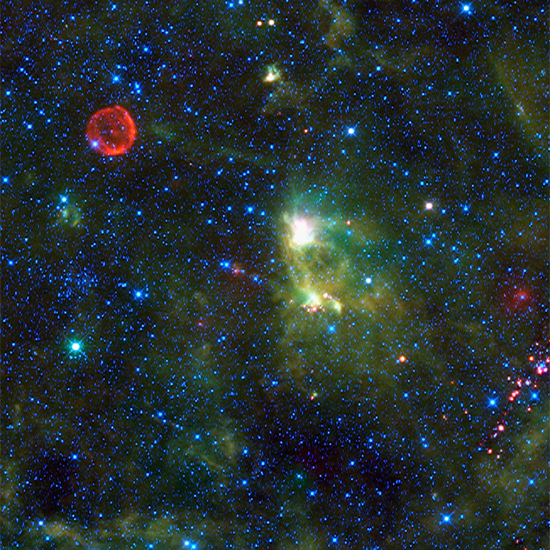
Composite wide-field infrared image, with SN1572 (Tycho Supernova Remnant) upper left. Blue and cyan indicate infrared wavelengths of 3.4 and 4.6 microns, while green and red show objects radiating at 12 and 22 microns. Credit: NASA/JPL-Caltech/WISE Team.
Mar 07, 2014
Shockwaves from exploding stars are in the news again.
According to a recent press release, the Tycho supernova remnant, SN1572, is affected by a “reverse shockwave” rebounding from the leading edge of its “impact” with interstellar gas and dust. The combination of a pulse traveling outward from its initial point of detonation at 300 times the speed of sound (368,000 kilometers per hour), coupled with a reverse wave crashing backward into it at 1000 times the speed of sound (1,225,000 kilometers per hour), is supposedly heating the expanding gas to the point where it is producing extremely short wavelength, high energy X-rays.
Every Picture of the Day article about supernovae takes issue with the idea that shockwaves, or kinetic effects, in general, are responsible for X-ray emissions. Hot gas, sonic booms, wind, turbulence, blast fronts, and other commonly applied causal events are insufficient when it comes to generating thermal radiation in the millions of degrees Celsius. In fact, astrophysicist Hiroya Yamaguchi, a member of the team studying the X-ray spectrum of SN1752, reported electrons moving outward from the paroxysm are heating up “by a still uncertain process”.
A past observation by the Chandra X-ray Observatory indicated several characteristics that could provide clues to the uncertain process that is puzzling researchers. The blast wave racing away from SN1752 is “a shell of extremely energetic electrons”. The expanding debris field also reveals something that surprised the consensus astronomical community: “X-ray stripes” never before observed in space.
Something of interest in the Chandra announcement; something that points to a more logical reason for the stripes and the energetic electrons, was a statement that “…supernova remnants can accelerate particles to energies a hundred times higher than achieved by the most powerful particle accelerator on Earth”—an almost direct quote from Electric Universe proponents. Unfortunately, because electricity is not part of the astronomical lexicon, they are confused by the process, preferring to think in terms of “tangled” and “amplified” magnetic fields caused by blast effects.
It is a standard principle of physics that, when heated to millions of degrees, gas becomes a plasma, since electrons are stripped from atomic nuclei at those temperatures. Electrons accelerated to high speeds will spiral in a magnetic field and give off X-rays. By that same token, protons and other positively charged ions can receive energy boosts that propel them into Earth’s electromagnetic field, where they are called “cosmic rays”.
Electric forces accelerate charged particles with energies of 10^20 electron volts, or more. Laboratory experiments with particle accelerators confirm the observation. For mechanical shock waves to achieve that power would mean a bang exceeding the most powerful supernova ever recorded. Instead of heat and explosive detonation, it is double layers in space that are the energetic components missing in astronomical theories.
Nobel prize winner Hannes Alfvén described a double layer as, “… a plasma formation by which a plasma—in the physical meaning of this word—protects itself from the environment. It is analogous to a cell wall by which a plasma—in the biological meaning of this word—protects itself from the environment.”
In the introduction to his book, Cosmic Plasma, he points out examples of plasma behavior in his lab that astronomers tend to ignore: “The plasma exhibited striations, double layers, and an assortment of oscillations and instabilities. The electron temperature was often found to be one or two orders of magnitude larger than the gas temperature, with the ion temperature intermediate.”
Hannes Alfvén is a godfather of Electric Universe theory. He would be pleased to see his ideas carried forward into honest investigations that do not rely on outdated theories. He considered astrophysical concepts to be outdated even in his day. Leaving the final word to him:
“The cosmical plasma physics of today . . . is to some extent the playground of theoreticians who have never seen a plasma in a laboratory. Many of them still believe in formulas which we know from laboratory experiments to be wrong . . . several of the basic concepts on which theories of cosmical plasmas are founded are not applicable to the condition prevailing in the cosmos. They are ‘generally accepted’ by most theoreticians, they are developed with the most sophisticated mathematical methods; and it is only the plasma itself which does not ‘understand’ how beautiful the theories are and absolutely refuses to obey them. . .”
Stephen Smith












